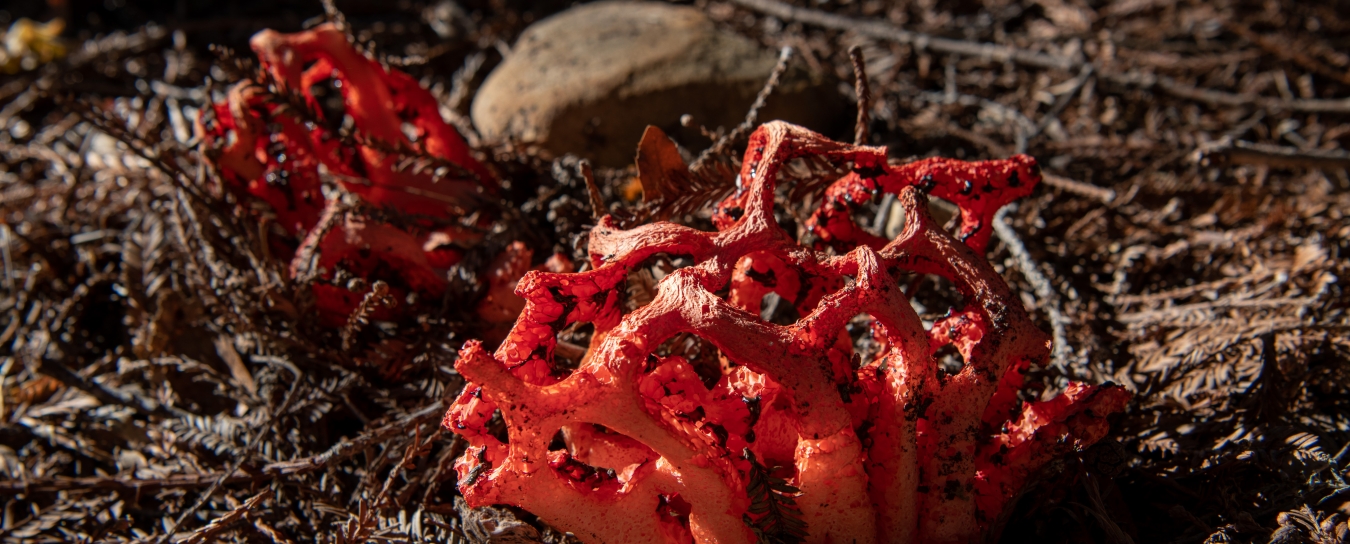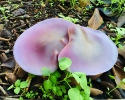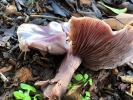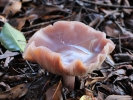
Fungi
Our fungi identifications are courtesy of fungi expert Bob Cummings, who teaches in the Botany Department at Santa Barbara City College in the Biological Sciences. Before you ask, check to see if your fungus has been identified below.
- Anthropology
- Rocks & Fossils
- Invertebrates
- Vertebrates
- Botany
- Astronomy
- Fungi
- General
- Recently Asked
Purple fungi
Hello!
Do you know what type of fungus this is? They have a very unique and pretty purple shade, and pop-up around this time of year (presumably due to the weather/rain?). I took this photo outside of my office at UCSB.
Thank you!
-Kevin

Curator Response
Hi Kevin,
Whenever we have a question that requires a fungi expert, we ask Bob Cummings, who teaches in the Botany Department at Santa Barbara City College in the Biological Sciences. He replied with tentative ID information, and a very important point about the limitations of trying to identify fungi without key details. Here's what he said:
"Mushroom identification relies on a variable set of 'key characteristics,' often subtle, but distinctive for positive ID. A common error made by beginners is to assume they can look at photos in a mushroom guide to come up with a reliable identification, rather than using the dichotomous keys (based on frustratingly esoteric terms) that describe in great detail the aforementioned key characteristics. Photos in a book can be misleading, and most if not all edible mushrooms have toxic 'look-alikes.'
Examples of some key characteristics include the presence or absence of a sac at the bottom of the stem, the color of the stem, the presence or absence of a ring on the stem, the type of attachment of the gills to the stem, the color of the spores (the color of the mature gills can be a good indication of spore color), etc.
Bottom line: the beautiful photo provided here doesn't show enough of the details mentioned above to identify it with certainty.
That being said, judging from the stunning amethyst purple color of the caps, these are blewits, Clitocybe nuda. If so, the stems will not have a sac at the base, nor a ring. The gills will be about the same color as the cap, and will leave a white to slightly purple spore print. Blewits are saprobic, found in live oak woodlands and urban gardens on thick mulch. They are considered edible (when cooked), but not 'choice' in my estimation. They are known to cause gastrointestinal distress if eaten raw.
And yes, there is a blewit look-alike. If the mushrooms in the photo have bulbous bases and rusty brown spores they will key out to Cortinarius glaucopus, which is listed in the field guides as 'edibility unknown' or 'probably toxic, to be avoided.'
Key characteristics are important."
Curator response:
Hello! Thank you for the great information you gave on my last post. Here are a couple more photos that might give some of the ID characteristics you were mentioning. Thanks again!
Kevin


Curator response:
Bob Cummings writes:
"Yes, now I can confirm this is the true Blewit, Clitocybe nuda. I can see the purple gill color, absence of a ring on the stem, and absence of a bulbous base. Mycologists usually make note of additional characteristics for identification, such as spore color (spore prints are always done on white paper, even for white-spored species), bruising reactions (color changes), smell, taste, season, habitat and associated plant species. Once back in the lab, mycologists will use a microscope to check for shape, size and ornamentation of spores, specialized cell types in the gills, cap and stipe. They will also perform chemical tests, such as adding drops of potassium hydroxide to cap tissue. KOH causes certain species to turn yellow. An important example would be that the 'death angel,' Amanita ocreata, yellows in KOH, but the 'death cap,' Amanita phalloides, does not."


